IDEX Online Research: Polished Diamond Prices Relatively Stable in April
May 04, 09
Polished diamond prices appear to have nearly leveled out, ending a free-fall that began in late 2008 and continued into early 2009, according to the IDEX Online Global Diamond Price Index. After peaking last summer, polished diamond prices declined sharply beginning in October 2008, a trend that continued through January. However, since February, polished diamond prices have remained more or less stable, with only a small dip at the end of March.
The following graph illustrates daily polished diamond prices for the past three months. It is clear that prices have been relatively stable since February.
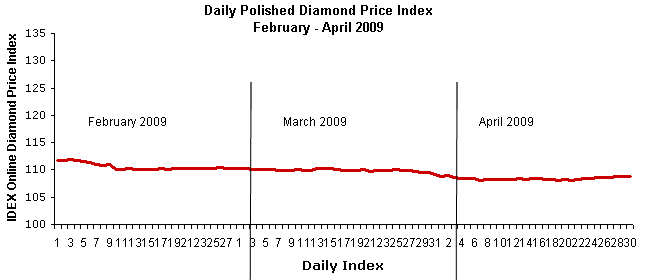
Source: IDEX Online
It is too early to tell if this trend of polished diamond price stabilization indicates that we may have reached the bottom of the price trough. However, there are some positive factors that that suggest polished diamond demand is firming, and polished diamond prices could stabilize, prior to potentially moving higher:
- U.S. jewelry retail sales have stabilized, so there is some optimism in the air. Granted, sales at specialty jewelers are now running about 90 percent of last year’s levels, but this is a significant improvement over the 80 percent level that characterized November and December 2008.
- Panic selling by diamond dealers has abated.
- Rough diamond suppliers cut back on mining activities, but some appear poised to restart mining operations due to increased demand. Rough diamond suppliers have played a major role in stabilizing polished diamond prices and bringing balance to the polished diamond market.
- Recent sales forecasts suggest that global diamond sales will be down by only low double-digit levels in 2009. Late last year, the sales pace slowed so much that it appeared retail sales of diamonds could collapse this year.
We continue to be impressed at the orderliness of trading in the polished diamond market. In the U.S., which represents just under half of the world’s demand by value, jewelry sales at specialty jewelers fell by 16 percent in the final quarter of the year, and were down just over 10 percent in the first two months of 2009.
Some forecasters estimate that these slowing retail trends translated to a 60 percent (or more) decline of rough diamond sales. De Beers’s first quarter production was down about 90 percent by volume. Despite these extremely weak results, polished diamond prices are down only about 16 percent from their peak, according to the IDEX Online Global Polished Price Index. If the polished diamond trading markets reacted like the U.S. stock market, prices could have fallen more than 50 percent, at least. Because the diamond market is a closed market without hedge funds and speculators, there has been far less price volatility than the public markets for other commodities.
Long Term Price Trend Weak
The graph below illustrates polished diamond prices for the past 24 months. While polished diamond prices may continue to remain weak for several more months, we believe that we are near the bottom. Positive signals have begun to emerge from the consumer market, especially in the U.S. As other global markets show signs of bottoming, it is likely that prices will firm up, and perhaps a gradual recovery will ensue. The recovery is reasonably likely to begin in the second half of 2009.
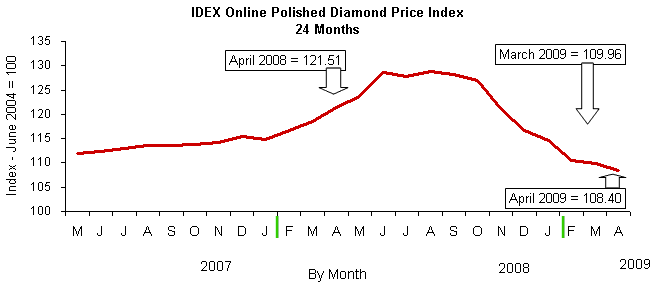
Source: IDEX Online
Monthly Polished Diamond Price Trends:
April 2009 versus March 2009: (1.4 percent)
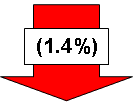 |
Not only is this much lower than in past months, but we anticipate that it will abate further in the coming months. The current deflationary trend is beneficial to downstream participants in the diamond pipeline since their margins have been squeezed for sometime, especially in mid-2008.
Unfortunately, the mining sector is reeling from sustained weak consumer demand; many mining operations shut down temporarily earlier this year.
We believe history is a great forecaster for the future. If so, the rate of diamond price deflation will likely moderate later this year, and the longer term inflation rate will return. It may be a few more months before we reach bottom, but prices will bottom at some point.
The IDEX Online Polished Diamond Price Index, calculated on the average daily prices during April 2009, stood at 108.40 for the month, down from 109.96 for the month of March 2009. On the last day of April, the IDEX Online Polished Diamond Price Index stood at 108.71, barely off from the 108.82 level registered on the first day of the month. This reflects firmness in prices during the month. The IDEX Polished Diamond Price Index stood at 100.00 in July 2004.
The graph below summarizes month-over-month changes in global diamond prices for the past thirteen months. Beginning in February 2008, polished diamond prices showed large gains during every month in the first half of the year. In mid-2008, price increases began moderating. In September, polished diamond prices began showing consistent month-to-month decreases, a trend that continues today, though in moderation.
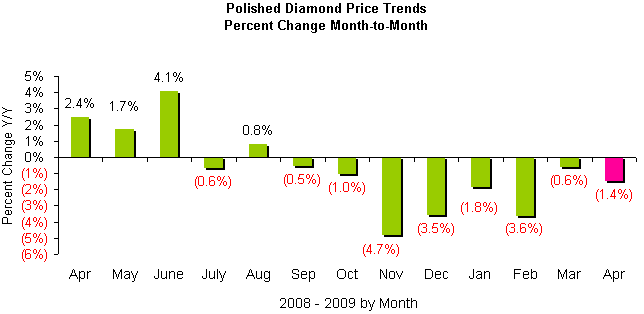
Source: IDEX Online
April 2009 versus April 2008: (10.8 percent)
On a year-over-year basis, global polished diamond prices dipped by 10.8 percent in April 2009 versus the same month a year ago. This was the tenth consecutive month of deceleration of year-over-year price increases for polished diamonds, and it was the fourth month that year-over-year prices dipped for polished diamonds. On a year-over-year basis, all key diamond sizes experienced price deflation. We think that polished diamond prices may continue to decline, though at a more modest rate. They have dipped below the historical trend line inflation rate of 3-4 percent annually, though we believe that they will eventually return to this historic rate of annual inflation. 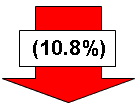
The historical inflation rate of 3-4 percent annually is sustainable, in our opinion, over the long term. While some forecasters are predicting a “new economy” where demand for luxury goods will be more muted and commodities prices won’t spike, diamonds and diamond demand have remained more or less on the sidelines during the recent turmoil in the commodities markets.
Thus, we believe that diamond demand and diamond prices are more likely to remain relatively untouched by potential commodity market volatility in the future, once the U.S. and the global economies stabilize. Further, based on 50,000 or more years of demand trends, we do not expect to see any major shift in consumer demand for diamonds or other jewelry as the global economy emerges from the current recession. Finally, we believe that polished diamond prices will ultimately reflect market demand and supply; when demand stabilizes, prices will also stabilize. The IDEX Online Polished Diamond Price Index stood at 108.40 in April 2009 versus 121.51 in April a year ago.
The graph below summarizes the year-over-year inflation rate by month for polished diamond prices in the global market for the past thirteen months. Comparisons are based on the daily average prices during the month versus the same month a year ago (e.g. April 2009 versus April 2008). The year-to-year comparison takes into account the seasonality of polished diamond demand and prices.
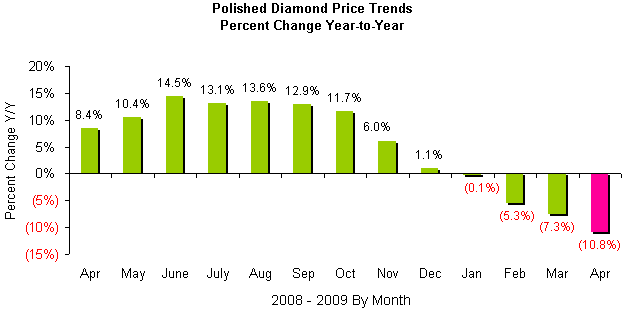
Source: IDEX Online
Prices for Large Polished Diamond Retracting More Rapidly
There’s an old adage: the bigger they are, the harder they fall. That adage could be applied to polished diamonds. Prices for the largest – and most expensive – diamonds rose faster and have generally fallen faster than prices for smaller, less expensive diamonds.
The graph below segments diamond price movements by key size. The diamonds shown on this graph represent about one-third of the market.
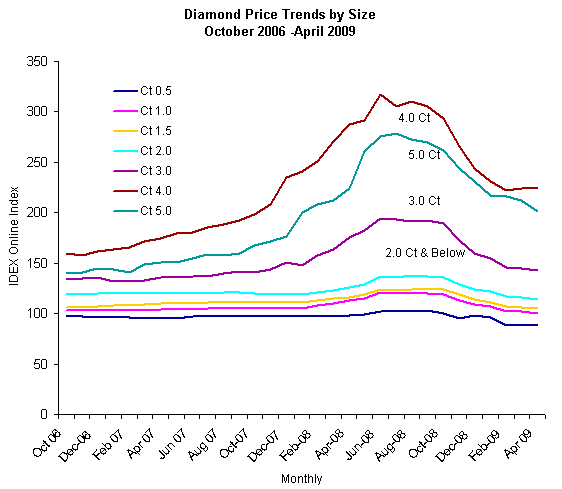
Source: IDEX Online
Month-to-Month Diamond Prices Decline for Key Sizes
Month-to-month price comparisons for polished diamond have shown some decline for all of the key sizes since last summer. While demand had been strong in 2007 and early 2008 for large diamonds – in the 4-5 carat range – retailers are now seeing shoppers who are willing to compromise on either quality or size. Worried consumers are opting for more modest, according to retail merchants’ reports. Thus, prices for these larger stones have shown a greater decline than some of the other key sizes over the past month.
The graph below summarizes the price changes for key sizes of polished diamonds on a month-over-month basis: April 2009 versus March 2009. These seven stone sizes represent about one-third of the trading market by value.
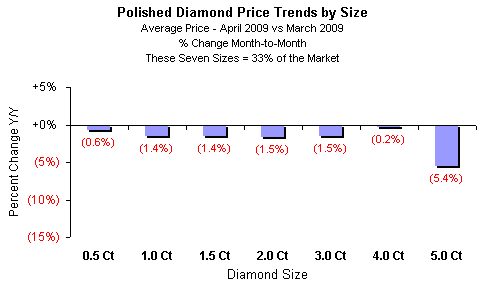
Source: IDEX Online
Year-Over-Year Diamond Prices for All Key Sizes Show Deflation
On a year-to-year comparison, polished diamond prices for the key sizes and qualities fell from the prior year. Almost all sizes of diamonds showed a double-digit loss in April. Comparisons were difficult, since there were a string of double-digit price gains for the larger diamond sizes in 2008.
The graph below summarizes polished diamond prices by key sizes on a year-over-year basis: April 2009 versus April 2008. These seven sizes represent about one-third of the market, by aggregate value.
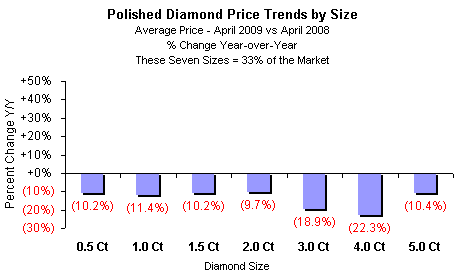 Source: IDEX Online |
Forecast: Diamond Prices Likely Near Bottom
We believe that polished diamond prices will likely show more modest declines in subsequent months, with a firming later this year. At some point, we believe that diamond prices will recover to their historic trend line, reflecting annual inflation of 3-4 percent.
While most of the global economies remain mired in a recession, the U.S. economy may have bottomed. Recent economic growth figures suggest that the weakest period may have been the fourth quarter of 2008. In fact, there are some signs that the U.S. economy is showing signs of life. After all, the U.S. government threw all of its defenses at the recession long before other nations began their own economic stimulus programs (in fact, some nations are still arguing about what to do – it is sort of like Nero fiddling while Rome burned).
We’ve learned two things in our many decades of following the U.S. economy and the U.S. government:
- The U.S. economy is far more resilient than most people understand.
- Don’t bet against the Fed, the government body which is engineering the stimulus to put U.S. economy back on track.
The IDEX Online Diamond Price Index
The IDEX Online Diamond Price Index is a real-time index derived from actual asking prices in the global diamond industry. The IDEX Online Diamond Price Index objectively reflects price trends as they happen. The Diamond Index and Diamond Drivers were formulated following comprehensive research and analysis of the IDEX inventory database, aggregated since 2001. Research and development were conducted in cooperation with Dr. Avi Wohl, Senior Lecturer of Finance at the faculty of Management, Tel Aviv University, Israel.
Additional information is available from IDEX Research. The e-mail address is diamondprices [at] idexonline [dot] com.